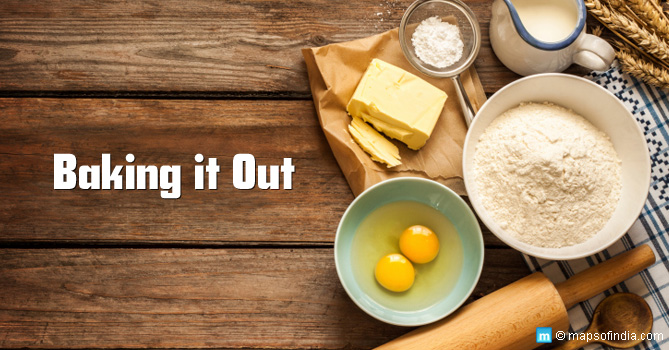If cooking is an art, then it can be safely said that baking is a science which creates masterpieces. Baking involves a keen understanding of proportions without which the masterpiece may end up in a flop show. The internet is full of recipes of the most lavish cakes. But understand that the ones who have baked these cakes are professionals and in most cases, with training and experience. So before you set out to bake the Lemon Meringue Pie or Éclairs, understand that you are still a novice and you need to take baby steps before you begin experimenting with the more difficult recipes.
The Basic Rules
- Prepping is of utmost importance. Get your kitchen scales and measuring cups and spoons and weigh the different ingredients to the exact gram and milligram.
- Use the proper measuring tools for different ingredients.
- Room temperature is the key to a successful baking expedition. The eggs, butter, and milk which are normally kept in the fridge have to be brought to room temperature if you want the baking to be a success.
- When the butter or shortening needs to be chilled, just put it in the freezer till you get it down to the required temperature.
- Always use unsalted butter. Even if salt is used in the recipe, you can always add the measured salt instead of playing a guessing game with the salted butter.
- Specific flour is available for baking cakes. Use this flour instead of the all-purpose flour.
- Sifting the dry ingredients is of utmost importance. Sifting fluffs the flour and also helps in filtering out impurities. It allows for a light, airy and delicate texture in a finished baked good.
- When mixing, take care as to not overdo it. When wet and dry ingredients are combined, you must just give it a fold or two, barely combining them. Over mixing will result in smooth domes instead of the desired crumbly ones.
- Over-kneading should also be avoided for biscuits, breads and pizzas.
- Pre-heating the oven is an absolute must. Do not throw in the mix into the oven unless and until the oven is at the right temperature. The science in baking will not accept such a folly and your baking will turn into a disaster.
- If you are using an old oven, you must place an oven thermometer in it to be sure of the temperature.
- Once the time for baking is over, you must cool the product on a rank. If not, the residual heat in the pan and the oven will end up overcooking the cake.
OTG v/s Microwave for Baking
In the years gone by, baking peels made of clay were used for the process of baking. Since the introduction of OTG, short for Oven-Toaster-Griller, cakes are baked in them. The OTG has heating elements on the roof as well at the bottom. Both the coils are turned on for the baking process to take place.
In recent years, the microwave ovens have been introduced into the market. Microwave ovens cook food with the help of moisture. The microwave oven with convection comes closest to the OTG. However, not all cakes can be baked in them, especially where browning is required.
If you are looking to bake every once in a while then microwave with convection will suit you fine. But if you plan to be a prolific baker, then you should go for an OTG.
Care for the Baking Tools
- Use a mild dish soap and hot water to clean the baking utensils.
- The baking sheets should be lined with parchment paper before using to avoid the stains left by sugar.
- Store the baking equipment in a dry cupboard.
- Clean the rolling pin with hot water, pat dry and store.
- Staining of baking stone is normal. Just wipe it clean with hot water. You can use steel wool every once in a while to clean it. When the surface starts to get uneven you can lightly sand it with medium-grit sandpaper and wipe it clean.
- Wash the pastry brush in hot soapy water several times and rinse. Soak the brush in a standard bleach solution for 15 minutes to sanitize it.
Storage of Ingredients
- Flour is best stored in airtight plastic bags in refrigerators. This will avoid clumping and also from it getting infested with worms or insects.
- Brown Sugar, yeast, baking powder and baking soda should also be kept in airtight containers in the fridge.
- Essences and spices used should be kept in a cool dry place, but never in the refrigerator.
- Do not refrigerate chocolate. Keep it well sealed in a cool dry place.
Baking is indeed a science. To master it, you need to have the patience, and also enjoy every step and procedure that comes along with it. Instead of directly leaping to a Black Forest Cake, learn to master the art of baking a sponge cake. Take baby steps and you will come out a winner. Happy Baking!!




